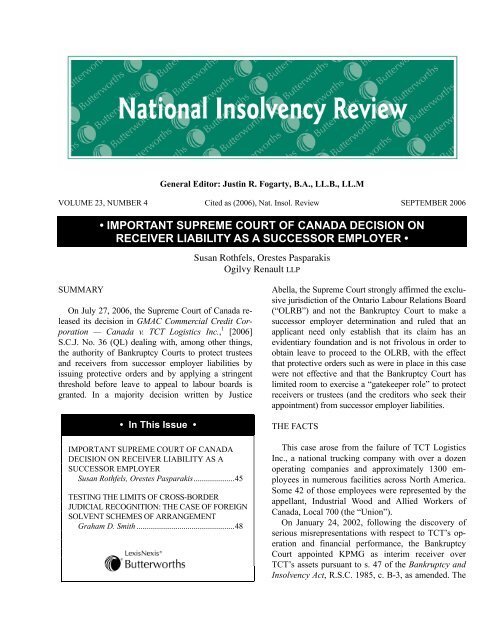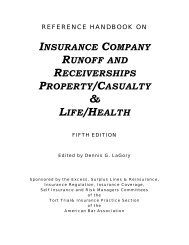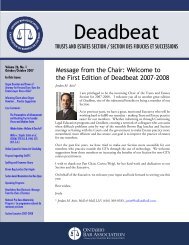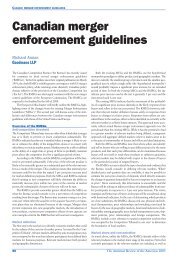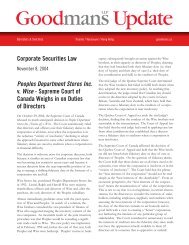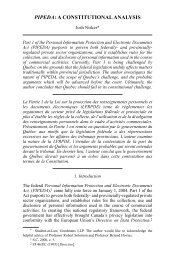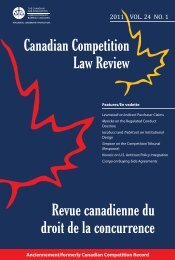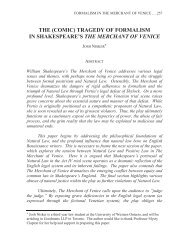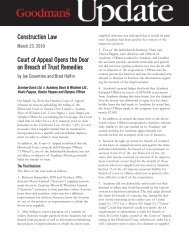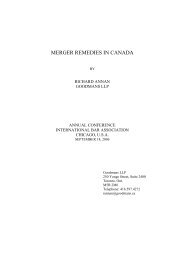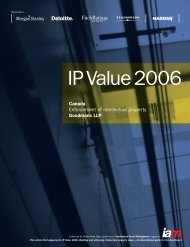important supreme court of canada decision on ... - Goodmans
important supreme court of canada decision on ... - Goodmans
important supreme court of canada decision on ... - Goodmans
Create successful ePaper yourself
Turn your PDF publications into a flip-book with our unique Google optimized e-Paper software.
General Editor: Justin R. Fogarty, B.A., LL.B., LL.M<br />
VOLUME 23, NUMBER 4 Cited as (2006), Nat. Insol. Review SEPTEMBER 2006<br />
• IMPORTANT SUPREME COURT OF CANADA DECISION ON<br />
RECEIVER LIABILITY AS A SUCCESSOR EMPLOYER •<br />
Susan Rothfels, Orestes Pasparakis<br />
Ogilvy Renault LLP<br />
SUMMARY<br />
On July 27, 2006, the Supreme Court <str<strong>on</strong>g>of</str<strong>on</strong>g> Canada released<br />
its <str<strong>on</strong>g>decisi<strong>on</strong></str<strong>on</strong>g> in GMAC Commercial Credit Corporati<strong>on</strong><br />
— Canada v. TCT Logistics Inc., 1 [2006]<br />
S.C.J. No. 36 (QL) dealing with, am<strong>on</strong>g other things,<br />
the authority <str<strong>on</strong>g>of</str<strong>on</strong>g> Bankruptcy Courts to protect trustees<br />
and receivers from successor employer liabilities by<br />
issuing protective orders and by applying a stringent<br />
threshold before leave to appeal to labour boards is<br />
granted. In a majority <str<strong>on</strong>g>decisi<strong>on</strong></str<strong>on</strong>g> written by Justice<br />
• In This Issue •<br />
IMPORTANT SUPREME COURT OF CANADA<br />
DECISION ON RECEIVER LIABILITY AS A<br />
SUCCESSOR EMPLOYER<br />
Susan Rothfels, Orestes Pasparakis....................45<br />
TESTING THE LIMITS OF CROSS-BORDER<br />
JUDICIAL RECOGNITION: THE CASE OF FOREIGN<br />
SOLVENT SCHEMES OF ARRANGEMENT<br />
Graham D. Smith ................................................48<br />
Abella, the Supreme Court str<strong>on</strong>gly affirmed the exclusive<br />
jurisdicti<strong>on</strong> <str<strong>on</strong>g>of</str<strong>on</strong>g> the Ontario Labour Relati<strong>on</strong>s Board<br />
(“OLRB”) and not the Bankruptcy Court to make a<br />
successor employer determinati<strong>on</strong> and ruled that an<br />
applicant need <strong>on</strong>ly establish that its claim has an<br />
evidentiary foundati<strong>on</strong> and is not frivolous in order to<br />
obtain leave to proceed to the OLRB, with the effect<br />
that protective orders such as were in place in this case<br />
were not effective and that the Bankruptcy Court has<br />
limited room to exercise a “gatekeeper role” to protect<br />
receivers or trustees (and the creditors who seek their<br />
appointment) from successor employer liabilities.<br />
THE FACTS<br />
This case arose from the failure <str<strong>on</strong>g>of</str<strong>on</strong>g> TCT Logistics<br />
Inc., a nati<strong>on</strong>al trucking company with over a dozen<br />
operating companies and approximately 1300 employees<br />
in numerous facilities across North America.<br />
Some 42 <str<strong>on</strong>g>of</str<strong>on</strong>g> those employees were represented by the<br />
appellant, Industrial Wood and Allied Workers <str<strong>on</strong>g>of</str<strong>on</strong>g><br />
Canada, Local 700 (the “Uni<strong>on</strong>”).<br />
On January 24, 2002, following the discovery <str<strong>on</strong>g>of</str<strong>on</strong>g><br />
serious misrepresentati<strong>on</strong>s with respect to TCT’s operati<strong>on</strong><br />
and financial performance, the Bankruptcy<br />
Court appointed KPMG as interim receiver over<br />
TCT’s assets pursuant to s. 47 <str<strong>on</strong>g>of</str<strong>on</strong>g> the Bankruptcy and<br />
Insolvency Act, R.S.C. 1985, c. B-3, as amended. The
Nati<strong>on</strong>al Insolvency Review September 2006 Volume 23, No. 4<br />
NATIONAL INSOLVENCY REVIEW<br />
The Nati<strong>on</strong>al Insolvency Review is published<br />
bi-m<strong>on</strong>thly by LexisNexis Canada Inc., 123 Commerce<br />
Valley Drive East, Suite 700, Markham, Ontario L3T<br />
7W8<br />
Design and Compilati<strong>on</strong> © LexisNexis Canada<br />
Inc. 2006. Unless otherwise stated, copyright in<br />
individual articles rests with the c<strong>on</strong>tributors.<br />
All rights reserved. No part <str<strong>on</strong>g>of</str<strong>on</strong>g> this publicati<strong>on</strong> may<br />
be reproduced or stored in any material form<br />
(including photocopying or storing it in any medium<br />
by electr<strong>on</strong>ic means and whether or not transiently or<br />
incidentally to some other use <str<strong>on</strong>g>of</str<strong>on</strong>g> this publicati<strong>on</strong>)<br />
without the written permissi<strong>on</strong> <str<strong>on</strong>g>of</str<strong>on</strong>g> the copyright<br />
holder except in accordance with the provisi<strong>on</strong>s <str<strong>on</strong>g>of</str<strong>on</strong>g><br />
the Copyright Act.<br />
ISBN: 0-433-43350-7 ISSN: 0822-2584<br />
ISBN: 0-433-44393-6 (Print & PDF)<br />
ISBN: 0-433-44674-9 (PDF)<br />
Subscripti<strong>on</strong> rates: $299 plus GST/year (Print or PDF)<br />
$365 plus GST/year (Print & PDF)<br />
Please address all editorial inquiries to:<br />
Verna Milner, Journals Editor<br />
LexisNexis Canada Inc.<br />
Tel. (905) 479-2665; Toll-Free Tel. 1-800-668-6481<br />
Fax (905) 479-2826; Toll-Free Fax 1-800-461-3275<br />
E-mail: nir@lexisnexis.ca.<br />
EDITORIAL BOARD<br />
GENERAL EDITOR<br />
Justin R. Fogarty, B.A., LL.B., LL.M.<br />
Bennett J<strong>on</strong>es LLP, Tor<strong>on</strong>to<br />
EDITORIAL BOARD MEMBERS<br />
• Gerald N. Apostolatos, Langlois Kr<strong>on</strong>ström Desjardins<br />
S.E.N.C.R.L./LLP, M<strong>on</strong>tréal • Frank Bennett, Bennett &<br />
Company, Tor<strong>on</strong>to • Nicolas Breart<strong>on</strong>, KPMG Inc.,<br />
Tor<strong>on</strong>to • David F.W. Cohen, Gowling Lafleur Henders<strong>on</strong><br />
LLP, Tor<strong>on</strong>to • Wayne Ehgoetz, C<strong>on</strong>gress Financial<br />
Corporati<strong>on</strong>, Tor<strong>on</strong>to • Jean-Yves Fortin, Brouillette<br />
Charpentier Fortin, M<strong>on</strong>tréal • William Neville, Neville<br />
ADR Services Inc., Ottawa • William Riley, Barrister &<br />
Solicitor, Vancouver • Melvin Zwaig, Zwaig C<strong>on</strong>sulting<br />
Inc., Tor<strong>on</strong>to.<br />
Note: This newsletter solicits manuscripts for c<strong>on</strong>siderati<strong>on</strong><br />
by the General Editor, who reserves the right to reject any<br />
manuscript or to publish it in revised form. The articles<br />
included in Nati<strong>on</strong>al Insolvency Review reflect the views <str<strong>on</strong>g>of</str<strong>on</strong>g><br />
the individual authors. This newsletter is not intended to<br />
provide legal or other pr<str<strong>on</strong>g>of</str<strong>on</strong>g>essi<strong>on</strong>al advice and readers should<br />
not act <strong>on</strong> the informati<strong>on</strong> c<strong>on</strong>tained in this report without<br />
seeking specific independent advice <strong>on</strong> the particular matters<br />
with which they are c<strong>on</strong>cerned.<br />
Receivership Order directed KPMG to take c<strong>on</strong>trol <str<strong>on</strong>g>of</str<strong>on</strong>g><br />
TCT’s property and operati<strong>on</strong>s as the <str<strong>on</strong>g>court</str<strong>on</strong>g>’s <str<strong>on</strong>g>of</str<strong>on</strong>g>ficer<br />
with a view to winding down the business in an orderly<br />
manner and specifically provided that KPMG<br />
would not be c<strong>on</strong>sidered a successor employer in so<br />
doing. It is <str<strong>on</strong>g>important</str<strong>on</strong>g> to note that at no time did the<br />
Uni<strong>on</strong> challenge such protective provisi<strong>on</strong>.<br />
KPMG quickly liquidated or shut down the various<br />
divisi<strong>on</strong>s and subsidiaries <str<strong>on</strong>g>of</str<strong>on</strong>g> TCT. The last major<br />
comp<strong>on</strong>ent <str<strong>on</strong>g>of</str<strong>on</strong>g> TCT’s business to be sold was the<br />
warehousing divisi<strong>on</strong>, which included the Uni<strong>on</strong>’s<br />
employees. The sale occurred within four m<strong>on</strong>ths <str<strong>on</strong>g>of</str<strong>on</strong>g><br />
the initial filing. The terms <str<strong>on</strong>g>of</str<strong>on</strong>g> the sale <str<strong>on</strong>g>of</str<strong>on</strong>g> that divisi<strong>on</strong><br />
as a going c<strong>on</strong>cern to a newly created company were<br />
approved by the Bankruptcy Court <strong>on</strong> notice to the<br />
Uni<strong>on</strong>.<br />
Pursuant to the agreement <str<strong>on</strong>g>of</str<strong>on</strong>g> sale, KPMG dismissed<br />
all employees except for those required to<br />
manage the wind down. The purchaser rehired approximately<br />
three-quarters <str<strong>on</strong>g>of</str<strong>on</strong>g> the warehousing divisi<strong>on</strong><br />
employees, including 19 <str<strong>on</strong>g>of</str<strong>on</strong>g> 42 <str<strong>on</strong>g>of</str<strong>on</strong>g> the Uni<strong>on</strong>’s<br />
active members.<br />
The Uni<strong>on</strong> applied to the OLRB seeking am<strong>on</strong>g<br />
other things a declarati<strong>on</strong> that the purchaser was a<br />
successor employer to TCT and/or KPMG. The OLRB<br />
stayed the applicati<strong>on</strong> as against KPMG pending the<br />
necessary <str<strong>on</strong>g>court</str<strong>on</strong>g> approval from the Bankruptcy Court<br />
pursuant to s. 215 <str<strong>on</strong>g>of</str<strong>on</strong>g> the Bankruptcy and Insolvency<br />
Act. Once again, it is noteworthy that the Uni<strong>on</strong> did<br />
not assert its successor employer claim until after the<br />
sale was completed.<br />
THE DECISIONS BELOW<br />
The Bankruptcy Court denied the Uni<strong>on</strong> leave to<br />
pursue its successorship employee. It amended the<br />
Receivership Order to provide that KPMG was <strong>on</strong>ly<br />
immunized from “successor employer” status if it was<br />
acting “qua realizer” (i.e., its operati<strong>on</strong> <str<strong>on</strong>g>of</str<strong>on</strong>g> the business<br />
was for the limited purpose <str<strong>on</strong>g>of</str<strong>on</strong>g> marshalling the assets<br />
for sale) and determined that, in the case <str<strong>on</strong>g>of</str<strong>on</strong>g> TCT, it<br />
had been doing so and should therefore be protected<br />
from such claims.<br />
On appeal, the majority <str<strong>on</strong>g>of</str<strong>on</strong>g> the Court <str<strong>on</strong>g>of</str<strong>on</strong>g> Appeal determined<br />
that the Bankruptcy Court had not properly<br />
applied the test for leave under s. 215 and remitted the<br />
issue <str<strong>on</strong>g>of</str<strong>on</strong>g> leave to be determined by that <str<strong>on</strong>g>court</str<strong>on</strong>g> in accordance<br />
with a test which c<strong>on</strong>sidered factors relating to<br />
the impact <str<strong>on</strong>g>of</str<strong>on</strong>g> the proposed claim up<strong>on</strong> the bankruptcy<br />
process. The Receivership Order was again amended<br />
46
Nati<strong>on</strong>al Insolvency Review September 2006 Volume 23, No. 4<br />
to delete the “qua realizer” qualificati<strong>on</strong> and to provide<br />
instead that the protecti<strong>on</strong> remained <strong>on</strong>ly unless<br />
or until a determinati<strong>on</strong> to the c<strong>on</strong>trary was made by<br />
the OLRB up<strong>on</strong> leave <str<strong>on</strong>g>of</str<strong>on</strong>g> the Bankruptcy Court.<br />
THE SUPREME COURT DECISION<br />
Justice Abella reversed the Court <str<strong>on</strong>g>of</str<strong>on</strong>g> Appeal and the<br />
Bankruptcy Court. Instead, she found:<br />
• the Bankruptcy Court does not have the jurisdicti<strong>on</strong><br />
to determine whether an interim receiver is a<br />
successor employer;<br />
• the Bankruptcy Court must apply the same uniform<br />
test for leave in all cases;<br />
• that test is the Mancini test (Mancini (Trustee <str<strong>on</strong>g>of</str<strong>on</strong>g>)<br />
v. Falc<strong>on</strong>i, [1993] O.J. No. 146 (C.A.) (QL)),<br />
which requires <strong>on</strong>ly a factual basis for a proposed<br />
claim which, as drafted, discloses a cause <str<strong>on</strong>g>of</str<strong>on</strong>g> acti<strong>on</strong><br />
against the receiver or trustee;<br />
• all other c<strong>on</strong>siderati<strong>on</strong>s are to be left to the OLRB<br />
and the Bankruptcy Court is not to make the final<br />
assessment <str<strong>on</strong>g>of</str<strong>on</strong>g> the merits <str<strong>on</strong>g>of</str<strong>on</strong>g> the claim.<br />
Justice Abella found that the test proposed by the<br />
majority in the Court <str<strong>on</strong>g>of</str<strong>on</strong>g> Appeal was inappropriate,<br />
both because it was “more vague and more elaborate”<br />
and because it undermined the OLRB’s jurisdicti<strong>on</strong><br />
over successorship determinati<strong>on</strong>s. She held instead<br />
that the Mancini test was sufficient to protect the integrity<br />
and efficiency <str<strong>on</strong>g>of</str<strong>on</strong>g> the bankruptcy process and<br />
that it was not inc<strong>on</strong>sistent with the desired “single<br />
c<strong>on</strong>trol” theory <str<strong>on</strong>g>of</str<strong>on</strong>g> bankruptcy litigati<strong>on</strong>.<br />
In the case <str<strong>on</strong>g>of</str<strong>on</strong>g> TCT, the Supreme Court was satisfied<br />
that the Mancini test was met (“it cannot be said<br />
that the Uni<strong>on</strong>’s claim is frivolous or without an evidentiary<br />
foundati<strong>on</strong>”) and directed that the claim<br />
should therefore proceed before the OLRB. Justice<br />
Abella indicated that the OLRB was the proper forum<br />
to address the arguments <str<strong>on</strong>g>of</str<strong>on</strong>g> KPMG and GMAC, as<br />
secured creditor, c<strong>on</strong>cerning the impact up<strong>on</strong> such a<br />
finding <strong>on</strong> the federal bankruptcy system and issues<br />
<str<strong>on</strong>g>of</str<strong>on</strong>g> c<strong>on</strong>stituti<strong>on</strong>al paramountcy.<br />
The Bankruptcy Court now has very clear guidance<br />
from the Supreme Court as to the test for leave to<br />
commence acti<strong>on</strong>s against trustees and receivers under<br />
s. 215 <str<strong>on</strong>g>of</str<strong>on</strong>g> the Bankruptcy and Insolvency Act. It is<br />
also clear that trustees and receivers cannot be ‘immunized’<br />
in any manner against successorship claims<br />
in their appointment orders. Finally, through dicta in<br />
her final remarks, Abella J. was critical <str<strong>on</strong>g>of</str<strong>on</strong>g> the practice<br />
<str<strong>on</strong>g>of</str<strong>on</strong>g> failing to provide uni<strong>on</strong>s with advance notice <str<strong>on</strong>g>of</str<strong>on</strong>g><br />
moti<strong>on</strong>s to appoint interim receivers. She did not accept<br />
the submissi<strong>on</strong>s <str<strong>on</strong>g>of</str<strong>on</strong>g> GMAC and KPMG in this<br />
case that such advance notice to the numerous stakeholders<br />
involved was impracticable — or indeed, impossible<br />
— in the circumstances. Instead, she urged<br />
that “advance negotiati<strong>on</strong>s” with uni<strong>on</strong>s in the future<br />
may lead to compromise rather than litigati<strong>on</strong>.<br />
It remains to be seen in what circumstances, if any,<br />
the OLRB will find that an interim receiver is a successor<br />
employer (with the result that such claims as<br />
terminati<strong>on</strong> and severance pay, which would otherwise<br />
rank after the secured creditors, will become<br />
their resp<strong>on</strong>sibility by virtue <str<strong>on</strong>g>of</str<strong>on</strong>g> indemnities and/or<br />
priority charges for the interim receiver). In the interim,<br />
creditors should be cognizant that a labour<br />
board, in c<strong>on</strong>sidering whether to impose successor<br />
employer liability, may have a different focus than a<br />
Bankruptcy Court which must c<strong>on</strong>sider and balance<br />
all stakeholder interests before it. The Supreme Court<br />
<str<strong>on</strong>g>decisi<strong>on</strong></str<strong>on</strong>g>, while procedural in nature, might also be<br />
seen as a shift in favour <str<strong>on</strong>g>of</str<strong>on</strong>g> uni<strong>on</strong> interests over secured<br />
creditors in the insolvency process and any uncertainty<br />
may force a re-examinati<strong>on</strong> <str<strong>on</strong>g>of</str<strong>on</strong>g>:<br />
• the reserves established by lenders;<br />
• the circumstances in which insolvent businesses<br />
c<strong>on</strong>tinue as a going c<strong>on</strong>cern; and<br />
• the importance <str<strong>on</strong>g>of</str<strong>on</strong>g> entering into prior agreements<br />
with any uni<strong>on</strong>s.<br />
Since the <str<strong>on</strong>g>decisi<strong>on</strong></str<strong>on</strong>g> was released, our law firm has already<br />
restructured <strong>on</strong>e imminent filing to eliminate any<br />
receiver-like powers and instead the creditor will rely<br />
solely up<strong>on</strong> the “M<strong>on</strong>itor” functi<strong>on</strong>s in a CCAA filing.<br />
[Editor’s note: Susan Rothfels and Orestes Pasparakis<br />
are both Partners at the law firm Ogilvy Renault LLP.<br />
Ms. Rothfels and Mr. Pasparakis were counsel to<br />
GMAC Commercial Credit Corporati<strong>on</strong> in this case.]<br />
1<br />
The full text <str<strong>on</strong>g>of</str<strong>on</strong>g> the <str<strong>on</strong>g>decisi<strong>on</strong></str<strong>on</strong>g> can be found at:<br />
.<br />
47
Nati<strong>on</strong>al Insolvency Review September 2006 Volume 23, No. 4<br />
• TESTING THE LIMITS OF CROSS-BORDER JUDICIAL RECOGNITION:<br />
THE CASE OF FOREIGN SOLVENT SCHEMES OF ARRANGEMENT •<br />
Graham D. Smith<br />
<strong>Goodmans</strong> LLP<br />
INTRODUCTION<br />
Canadian <str<strong>on</strong>g>court</str<strong>on</strong>g>s have l<strong>on</strong>g been willing to recognize<br />
and give assistance to foreign proceedings and<br />
judgments where various recogniti<strong>on</strong> criteria are<br />
met. These criteria have evolved and expanded over<br />
time, reflecting the expansi<strong>on</strong> <str<strong>on</strong>g>of</str<strong>on</strong>g> global commerce<br />
and cross-border transacti<strong>on</strong>s. The primary focus <str<strong>on</strong>g>of</str<strong>on</strong>g><br />
the current test for recogniti<strong>on</strong> is whether the foreign<br />
proceeding bears a real and substantial c<strong>on</strong>necti<strong>on</strong> to<br />
the acti<strong>on</strong>. 1 The evoluti<strong>on</strong> <str<strong>on</strong>g>of</str<strong>on</strong>g> recogniti<strong>on</strong> criteria has<br />
in recent years included statutory jurisdicti<strong>on</strong> to recognize<br />
certain foreign insolvency proceedings. 2<br />
The boundaries <str<strong>on</strong>g>of</str<strong>on</strong>g> recogniti<strong>on</strong> <str<strong>on</strong>g>of</str<strong>on</strong>g> foreign proceedings<br />
c<strong>on</strong>tinue to be tested, however, as shown in the<br />
Ontario case <str<strong>on</strong>g>of</str<strong>on</strong>g> Re Cavell Insurance Co. 3 One U.K.<br />
commentator observed the trial level <str<strong>on</strong>g>decisi<strong>on</strong></str<strong>on</strong>g> was<br />
“certainly commendable in its internati<strong>on</strong>alist approach”<br />
and “chimes with the general global trend <str<strong>on</strong>g>of</str<strong>on</strong>g><br />
facilitating cross-border restructuring”. 4 The case<br />
raises, however, fundamental questi<strong>on</strong>s as to how far<br />
the boundaries <str<strong>on</strong>g>of</str<strong>on</strong>g> recogniti<strong>on</strong> should be stretched in<br />
the case <str<strong>on</strong>g>of</str<strong>on</strong>g> certain types <str<strong>on</strong>g>of</str<strong>on</strong>g> foreign proceedings, and<br />
as to the role <str<strong>on</strong>g>of</str<strong>on</strong>g> c<strong>on</strong>diti<strong>on</strong>al recogniti<strong>on</strong> as a device<br />
in the recogniti<strong>on</strong> process.<br />
BACKGROUND<br />
Cavell, a company based in L<strong>on</strong>d<strong>on</strong>, England, is a<br />
“reinsurer”. Its business is to issue insurance coverage<br />
(i.e., ‘reinsurance’) to insurance companies that<br />
in turn have issued policies to their policyholders. In<br />
the early 1990s, Cavell ceased to issue new policies<br />
and it entered into what is known as a “run-<str<strong>on</strong>g>of</str<strong>on</strong>g>f” <str<strong>on</strong>g>of</str<strong>on</strong>g><br />
its reinsurance business, administering its assets and<br />
dealing with its liabilities as they c<strong>on</strong>tinue to develop<br />
under those policies issued while it was still<br />
underwriting. The run-<str<strong>on</strong>g>of</str<strong>on</strong>g>f was estimated to take a<br />
few decades to run its course. Given the nature <str<strong>on</strong>g>of</str<strong>on</strong>g><br />
the risks that Cavell covered, many claims were expected<br />
to be made, and/or to reach a state where they<br />
can be finalized, <strong>on</strong>ly many years after the policies<br />
were issued.<br />
Cavell operated a Canadian branch under the provisi<strong>on</strong>s<br />
<str<strong>on</strong>g>of</str<strong>on</strong>g> the Insurance Companies Act, 5 and its<br />
predecessor legislati<strong>on</strong>. Cavell’s estimate <str<strong>on</strong>g>of</str<strong>on</strong>g> the<br />
value <str<strong>on</strong>g>of</str<strong>on</strong>g> its remaining known and unknown liabilities<br />
under its Canadian branch policies was, at the<br />
time <str<strong>on</strong>g>of</str<strong>on</strong>g> the hearing, approximately $6 milli<strong>on</strong>. Cavell<br />
had approximately $23 milli<strong>on</strong> <str<strong>on</strong>g>of</str<strong>on</strong>g> assets in Canada,<br />
most <str<strong>on</strong>g>of</str<strong>on</strong>g> which were vested in a trust pursuant to<br />
Canada’s legislative and regulatory requirements in<br />
respect <str<strong>on</strong>g>of</str<strong>on</strong>g> foreign insurers that operate Canadian<br />
branches. Under the federal insurance regime, the<br />
trust assets are effectively held for the benefit <str<strong>on</strong>g>of</str<strong>on</strong>g><br />
holders <str<strong>on</strong>g>of</str<strong>on</strong>g> policies issued by the Canadian branch,<br />
c<strong>on</strong>stituting de facto security for payment <str<strong>on</strong>g>of</str<strong>on</strong>g> the<br />
branch’s potential liabilities in the event the foreign<br />
insurer becomes insolvent.<br />
THE FOREIGN SCHEME OF ARRANGEMENT<br />
Schemes <str<strong>on</strong>g>of</str<strong>on</strong>g> arrangement under s. 425 <str<strong>on</strong>g>of</str<strong>on</strong>g> the<br />
Companies Act 1985 (U.K.) are an established<br />
mechanism for finalizing the affairs <str<strong>on</strong>g>of</str<strong>on</strong>g> insolvent<br />
companies to which the Act applies. Recently, however,<br />
many solvent U.K. insurance or reinsurance<br />
companies that are in run-<str<strong>on</strong>g>of</str<strong>on</strong>g>f have resorted to<br />
schemes <str<strong>on</strong>g>of</str<strong>on</strong>g> arrangement as an exit strategy to terminate<br />
all their policy liabilities, to put an early end to<br />
the run-<str<strong>on</strong>g>of</str<strong>on</strong>g>f, and to free up the remaining capital that<br />
would otherwise be held to back those liabilities.<br />
In late 2004, Cavell announced it was putting<br />
forth a solvent scheme <str<strong>on</strong>g>of</str<strong>on</strong>g> arrangement. As is typical<br />
under solvent schemes, holders <str<strong>on</strong>g>of</str<strong>on</strong>g> Cavell reinsurance<br />
policies would be required to file for the value<br />
<str<strong>on</strong>g>of</str<strong>on</strong>g> not <strong>on</strong>ly all their known claims under those policies<br />
as at a fixed date, but all future and unknown<br />
claims. This necessarily requires an estimate <str<strong>on</strong>g>of</str<strong>on</strong>g> loss<br />
claims that will be incurred, possibly over many<br />
years. If a claimant and the scheme administrator<br />
cannot agree <strong>on</strong> the value <str<strong>on</strong>g>of</str<strong>on</strong>g> a claim, an adjudicator<br />
chosen by Cavell would make a final, binding estimate<br />
valuati<strong>on</strong>, which would then be payable in accordance<br />
with the terms <str<strong>on</strong>g>of</str<strong>on</strong>g> the scheme. All rights <str<strong>on</strong>g>of</str<strong>on</strong>g><br />
Cavell’s policyholders to any other payment (including<br />
for any actual losses incurred in excess <str<strong>on</strong>g>of</str<strong>on</strong>g> the<br />
48
Nati<strong>on</strong>al Insolvency Review September 2006 Volume 23, No. 4<br />
estimate) would be fully extinguished and the policies<br />
would be terminated.<br />
Until Cavell’s scheme, no solvent foreign insurer<br />
had sought to enforce such a scheme <strong>on</strong> policyholders<br />
<str<strong>on</strong>g>of</str<strong>on</strong>g> the insurer’s Canadian branch.<br />
THE FOREIGN PROCEEDINGS AND THE<br />
RECOGNITION ORDER<br />
In accordance with the practice in the U.K. <str<strong>on</strong>g>court</str<strong>on</strong>g>s,<br />
Cavell first obtained an ‘initial order’ <str<strong>on</strong>g>of</str<strong>on</strong>g> the U.K.<br />
<str<strong>on</strong>g>court</str<strong>on</strong>g> authorizing the proposed meeting <str<strong>on</strong>g>of</str<strong>on</strong>g> scheme<br />
claimants and providing for notice <str<strong>on</strong>g>of</str<strong>on</strong>g> scheme proceedings.<br />
Cavell then moved before the Commercial<br />
List in the Ontario Superior Court and was granted<br />
an order:<br />
• recognizing the U.K. proceedings and the initial<br />
U.K. order;<br />
• limiting claimants with claims against Cavell’s<br />
Canadian assets to pursuing such claims in the<br />
U.K. scheme proceedings;<br />
• permitting Cavell, up<strong>on</strong> approval by a requisite<br />
majority <str<strong>on</strong>g>of</str<strong>on</strong>g> Cavell’s scheme creditors and the<br />
U.K. <str<strong>on</strong>g>court</str<strong>on</strong>g> at a sancti<strong>on</strong> hearing, to apply to the<br />
Ontario <str<strong>on</strong>g>court</str<strong>on</strong>g> for scheme approval and such further<br />
orders as deemed necessary, including orders<br />
in respect <str<strong>on</strong>g>of</str<strong>on</strong>g> the claims process to be<br />
instituted under the scheme; and<br />
• staying all proceedings against Cavell or its<br />
Canadian assets, unless leave <str<strong>on</strong>g>of</str<strong>on</strong>g> the Ontario<br />
<str<strong>on</strong>g>court</str<strong>on</strong>g> is first obtained.<br />
Several policyholders <str<strong>on</strong>g>of</str<strong>on</strong>g> Cavell’s Canadian<br />
branch took issue with the Ontario recogniti<strong>on</strong> order,<br />
and moved under its comeback provisi<strong>on</strong> to have it<br />
set aside or varied. On the comeback hearing, the<br />
Ontario <str<strong>on</strong>g>court</str<strong>on</strong>g>:<br />
• c<strong>on</strong>firmed its jurisdicti<strong>on</strong> to recognize and assist<br />
the U.K. scheme proceedings, and<br />
• c<strong>on</strong>firmed that the scheme proceedings would in<br />
fact be recognized.<br />
The trial <str<strong>on</strong>g>court</str<strong>on</strong>g>’s <str<strong>on</strong>g>decisi<strong>on</strong></str<strong>on</strong>g> was appealed to the<br />
Court <str<strong>on</strong>g>of</str<strong>on</strong>g> Appeal. The Court <str<strong>on</strong>g>of</str<strong>on</strong>g> Appeal rejected, and<br />
overturned, the statutory basis <str<strong>on</strong>g>of</str<strong>on</strong>g> the trial <str<strong>on</strong>g>decisi<strong>on</strong></str<strong>on</strong>g>.<br />
At the same time, it upheld the recogniti<strong>on</strong> <str<strong>on</strong>g>of</str<strong>on</strong>g> the<br />
initial U.K. order <strong>on</strong> the basis <str<strong>on</strong>g>of</str<strong>on</strong>g> private internati<strong>on</strong>al<br />
law, and significantly expanded the comm<strong>on</strong> law<br />
parameters for recogniti<strong>on</strong> <str<strong>on</strong>g>of</str<strong>on</strong>g> foreign orders.<br />
The facts <str<strong>on</strong>g>of</str<strong>on</strong>g> this case, and the expanding popularity<br />
<str<strong>on</strong>g>of</str<strong>on</strong>g> foreign solvent schemes, bring to the fore issues<br />
that likely will be subject to further debate in a<br />
judicial or legislative c<strong>on</strong>text (or both), as the<br />
boundaries <str<strong>on</strong>g>of</str<strong>on</strong>g> cross-border recogniti<strong>on</strong> c<strong>on</strong>tinue to<br />
be explored.<br />
BASIS FOR THE RECOGNITION ORDER<br />
No Canadian statute expressly c<strong>on</strong>fers jurisdicti<strong>on</strong><br />
to recognize or assist foreign solvent schemes <str<strong>on</strong>g>of</str<strong>on</strong>g> arrangement.<br />
Re Cavell held there was jurisdicti<strong>on</strong> to<br />
do this, however.<br />
STATUTORY<br />
At the trial level, jurisdicti<strong>on</strong> was firstly found<br />
under Ontario’s Reciprocal Enforcement <str<strong>on</strong>g>of</str<strong>on</strong>g> Judgments<br />
(UK) Act, 6 which implements the Canada-<br />
U.K. C<strong>on</strong>venti<strong>on</strong> Providing for the Reciprocal<br />
Recogniti<strong>on</strong> and Enforcement <str<strong>on</strong>g>of</str<strong>on</strong>g> Judgments in Civil<br />
and Commercial Matters (the “C<strong>on</strong>venti<strong>on</strong>”). The<br />
trial <str<strong>on</strong>g>court</str<strong>on</strong>g> in Re Cavell rejected an argument that<br />
the U.K. initial order was not a “judgment” for the<br />
purposes <str<strong>on</strong>g>of</str<strong>on</strong>g> the recogniti<strong>on</strong> provisi<strong>on</strong>s <str<strong>on</strong>g>of</str<strong>on</strong>g> the C<strong>on</strong>venti<strong>on</strong>.<br />
Also, although the C<strong>on</strong>venti<strong>on</strong> provides<br />
that it does not apply to judgments that determine<br />
the winding-up <str<strong>on</strong>g>of</str<strong>on</strong>g> companies, the <str<strong>on</strong>g>court</str<strong>on</strong>g> held that<br />
the U.K. order did not fall within this exclusi<strong>on</strong>, as<br />
a solvent scheme <str<strong>on</strong>g>of</str<strong>on</strong>g> arrangement was not a winding-up<br />
or akin to <strong>on</strong>e. The <str<strong>on</strong>g>court</str<strong>on</strong>g> observed, however,<br />
that the C<strong>on</strong>venti<strong>on</strong> “is a difficult read and awkwardly<br />
presented”. 7<br />
On appeal, the statutory basis for recognizing the<br />
U.K. order was squarely rejected, however. The<br />
Court <str<strong>on</strong>g>of</str<strong>on</strong>g> Appeal held that the U.K. order was not<br />
recognizable under the C<strong>on</strong>venti<strong>on</strong> because (i) the<br />
U.K. proceeding had not been served <strong>on</strong> the Canadian<br />
parties, and (ii) the U.K. order was not a “final<br />
order” within the meaning <str<strong>on</strong>g>of</str<strong>on</strong>g> the C<strong>on</strong>venti<strong>on</strong>.<br />
PRIVATE INTERNATIONAL LAW<br />
The <str<strong>on</strong>g>court</str<strong>on</strong>g> in Re Cavell invoked a sec<strong>on</strong>d, independent<br />
ground for recognizing the U.K. proceed-<br />
49
Nati<strong>on</strong>al Insolvency Review September 2006 Volume 23, No. 4<br />
ings: the principle <str<strong>on</strong>g>of</str<strong>on</strong>g> comity, effected through the<br />
vehicle <str<strong>on</strong>g>of</str<strong>on</strong>g> inherent jurisdicti<strong>on</strong>. The objecting Canadian<br />
policyholders argued that it was not an appropriate<br />
case to invoke the comity principle, since the<br />
process under the U.K.’s Companies Act 1985 significantly<br />
diverged from the voluntary dissoluti<strong>on</strong><br />
process that would apply under Canadian legislati<strong>on</strong>,<br />
and since they would lose the unique benefit from<br />
having the Canadian security for potential losses that<br />
they may claim under their policies. The trial <str<strong>on</strong>g>court</str<strong>on</strong>g><br />
rejected this positi<strong>on</strong>, citing its c<strong>on</strong>clusi<strong>on</strong> that the<br />
scheme was not a dissoluti<strong>on</strong> or winding-up, and the<br />
fact that Canadian insurance regulator would retain<br />
c<strong>on</strong>trol over the release <str<strong>on</strong>g>of</str<strong>on</strong>g> the vested assets. 8<br />
The Court <str<strong>on</strong>g>of</str<strong>on</strong>g> Appeal not <strong>on</strong>ly upheld the recogniti<strong>on</strong><br />
<str<strong>on</strong>g>of</str<strong>on</strong>g> the U.K. order <strong>on</strong> the basis <str<strong>on</strong>g>of</str<strong>on</strong>g> private internati<strong>on</strong>al<br />
law, but went some distance to expand the<br />
boundaries <str<strong>on</strong>g>of</str<strong>on</strong>g> recogniti<strong>on</strong> <strong>on</strong> this basis. The Court <str<strong>on</strong>g>of</str<strong>on</strong>g><br />
Appeal noted that although traditi<strong>on</strong>ally under<br />
Canadian law a foreign order must be final and res<br />
judicata in the foreign jurisdicti<strong>on</strong> (i.e., the foreign<br />
<str<strong>on</strong>g>court</str<strong>on</strong>g> no l<strong>on</strong>ger has the power to rescind or vary it),<br />
those prerequisites should no l<strong>on</strong>ger apply. Rather,<br />
the focus should be <strong>on</strong> whether the purpose <str<strong>on</strong>g>of</str<strong>on</strong>g> those<br />
requirements has been met. The Court <str<strong>on</strong>g>of</str<strong>on</strong>g> Appeal<br />
defined the purpose <str<strong>on</strong>g>of</str<strong>on</strong>g> the traditi<strong>on</strong>al finality requirement<br />
to be as “at least” threefold:<br />
• to ensure the domestic <str<strong>on</strong>g>court</str<strong>on</strong>g> knows precisely<br />
what it is agreeing to recognize and enforce;<br />
• to remove the risk <str<strong>on</strong>g>of</str<strong>on</strong>g> the injustice that would be<br />
d<strong>on</strong>e to the party against whom the foreign order<br />
is enforced if that order is subsequently changed<br />
by the foreign <str<strong>on</strong>g>court</str<strong>on</strong>g>; and<br />
• to remove the risk <str<strong>on</strong>g>of</str<strong>on</strong>g> undermining public c<strong>on</strong>fidence<br />
that might arise if the domestic <str<strong>on</strong>g>court</str<strong>on</strong>g> were<br />
to issue a recogniti<strong>on</strong> order, <strong>on</strong>ly to have the<br />
foundati<strong>on</strong> <str<strong>on</strong>g>of</str<strong>on</strong>g> that order, namely the foreign order,<br />
disappear.<br />
The Court <str<strong>on</strong>g>of</str<strong>on</strong>g> Appeal recognized that obviously<br />
the initial U.K. order did not in fact finally decide<br />
the substantive issue affecting Cavell and the Canadian<br />
policyholders because it did not approve the<br />
scheme <str<strong>on</strong>g>of</str<strong>on</strong>g> arrangement and it merely commenced<br />
the procedure which may lead to the U.K. <str<strong>on</strong>g>court</str<strong>on</strong>g> ultimately<br />
approving the scheme. However, because it<br />
found the U.K. order:<br />
• to be “undoubtedly clear and certain”;<br />
• to present “little if any risk <str<strong>on</strong>g>of</str<strong>on</strong>g> injustice” to the<br />
Canadian policyholders; and<br />
• to have “little risk <str<strong>on</strong>g>of</str<strong>on</strong>g> undermining public c<strong>on</strong>fidence<br />
if the procedure initiated by the U.K. order<br />
is changed following its recogniti<strong>on</strong> by the<br />
Ontario <str<strong>on</strong>g>court</str<strong>on</strong>g>”, the purpose <str<strong>on</strong>g>of</str<strong>on</strong>g> the traditi<strong>on</strong>al finality<br />
requirement was met here. 9<br />
The Court <str<strong>on</strong>g>of</str<strong>on</strong>g> Appeal stated that: 10<br />
…in an age where the rules <str<strong>on</strong>g>of</str<strong>on</strong>g> private internati<strong>on</strong>al<br />
law are evolving to accommodate the increasingly<br />
transnati<strong>on</strong>al nature <str<strong>on</strong>g>of</str<strong>on</strong>g> commerce, I see no reas<strong>on</strong><br />
why this result should be precluded by those rules<br />
just because the foreign order to be recognized is not<br />
final. In my view the want <str<strong>on</strong>g>of</str<strong>on</strong>g> finality carries with it<br />
no substantive effect that should deny recogniti<strong>on</strong>.<br />
The Court <str<strong>on</strong>g>of</str<strong>on</strong>g> Appeal also expressly held that there<br />
were “str<strong>on</strong>g policy reas<strong>on</strong>s” for giving recogniti<strong>on</strong> to<br />
the initial U.K. order. In particular, “[t]he doctrine <str<strong>on</strong>g>of</str<strong>on</strong>g><br />
comity is well served by an Ontario recogniti<strong>on</strong><br />
order”, as is “[t]he related noti<strong>on</strong> <str<strong>on</strong>g>of</str<strong>on</strong>g> reciprocity”. 11<br />
With respect to the latter, the <str<strong>on</strong>g>court</str<strong>on</strong>g> stated that each <str<strong>on</strong>g>of</str<strong>on</strong>g><br />
the Canada Business Corporati<strong>on</strong>s Act and the Business<br />
Corporati<strong>on</strong>s Act (Ontario) has procedures for<br />
approving solvent schemes <str<strong>on</strong>g>of</str<strong>on</strong>g> arrangement, and: 12<br />
If an Ontario <str<strong>on</strong>g>court</str<strong>on</strong>g> were administering such a<br />
scheme, and it affected interests in the United<br />
Kingdom, the <str<strong>on</strong>g>court</str<strong>on</strong>g> would hope for the same recogniti<strong>on</strong><br />
<str<strong>on</strong>g>of</str<strong>on</strong>g> its orders as is sought in this case.<br />
The Court <str<strong>on</strong>g>of</str<strong>on</strong>g> Appeal also held that, under private internati<strong>on</strong>al<br />
law, the failure to serve the Canadian interests<br />
with the U.K. proceeding was irrelevant, as the<br />
Canadian interests had been accorded “a fair process”.<br />
Lastly, the Court <str<strong>on</strong>g>of</str<strong>on</strong>g> Appeal held that the “real and<br />
substantial c<strong>on</strong>necti<strong>on</strong> test” was met in this case, as<br />
the subject matter was a scheme <str<strong>on</strong>g>of</str<strong>on</strong>g> arrangement proposed<br />
by a U.K. company under U.K. law and it<br />
would affect all the creditors <str<strong>on</strong>g>of</str<strong>on</strong>g> the company, <strong>on</strong>ly a<br />
small percentage <str<strong>on</strong>g>of</str<strong>on</strong>g> which are in Canada.<br />
CONDITIONS ON RECOGNITION<br />
In an interesting aspect <str<strong>on</strong>g>of</str<strong>on</strong>g> Re Cavell, the trial<br />
<str<strong>on</strong>g>court</str<strong>on</strong>g> did not grant carte blanche recogniti<strong>on</strong> to the<br />
50
Nati<strong>on</strong>al Insolvency Review September 2006 Volume 23, No. 4<br />
U.K. proceedings, however. Rather, the <str<strong>on</strong>g>court</str<strong>on</strong>g> recognized<br />
the Canadian parties’ “valid criticism” that<br />
under the scheme the adjudicator <str<strong>on</strong>g>of</str<strong>on</strong>g> claims would<br />
have absolute discreti<strong>on</strong> with respect to making his<br />
determinati<strong>on</strong>, which would be final and binding and<br />
“absent any meaningful right <str<strong>on</strong>g>of</str<strong>on</strong>g> appeal”. The <str<strong>on</strong>g>court</str<strong>on</strong>g><br />
thus imposed express c<strong>on</strong>diti<strong>on</strong>s <strong>on</strong> its recogniti<strong>on</strong>,<br />
including that:<br />
• the scheme adjudicator must reach a valuati<strong>on</strong><br />
based <strong>on</strong> the Canadian rules applying to valuati<strong>on</strong>s,<br />
recognizing that Canada requires the trust<br />
assets to be held;<br />
• there will be a right <str<strong>on</strong>g>of</str<strong>on</strong>g> judicial appeal if the<br />
scheme adjudicator fails to apply the Canadian<br />
rules; and<br />
• the scheme administrator and the scheme adjudicator<br />
must act in good faith and treat the<br />
Canadian policyholders fairly. 13<br />
These c<strong>on</strong>diti<strong>on</strong>s were not changed by the Court <str<strong>on</strong>g>of</str<strong>on</strong>g><br />
Appeal.<br />
The <str<strong>on</strong>g>court</str<strong>on</strong>g>’s use <str<strong>on</strong>g>of</str<strong>on</strong>g> c<strong>on</strong>diti<strong>on</strong>s <strong>on</strong> recogniti<strong>on</strong> <str<strong>on</strong>g>of</str<strong>on</strong>g><br />
the foreign order appears to be an attempt to<br />
“finesse” the effect <str<strong>on</strong>g>of</str<strong>on</strong>g> the foreign proceeding where<br />
it did not at its root <str<strong>on</strong>g>of</str<strong>on</strong>g>fend the Canadian <str<strong>on</strong>g>court</str<strong>on</strong>g> so as<br />
to justify outright refusal to grant recogniti<strong>on</strong>, but<br />
where some aspects <str<strong>on</strong>g>of</str<strong>on</strong>g> the foreign proceeding appeared<br />
to the <str<strong>on</strong>g>court</str<strong>on</strong>g> to require adjustment to protect<br />
legitimate Canadian c<strong>on</strong>cerns. It will be interesting<br />
to see whether this c<strong>on</strong>diti<strong>on</strong>al technique is adopted<br />
by Canadian <str<strong>on</strong>g>court</str<strong>on</strong>g>s in future cases.<br />
TESTING THE LIMITS — THE ‘UNIVERSALIST’<br />
APPROACH AND THE ROLE OF PUBLIC POLICY<br />
One <str<strong>on</strong>g>of</str<strong>on</strong>g> the grounds l<strong>on</strong>g-recognized in the comm<strong>on</strong><br />
law for refusing recogniti<strong>on</strong> <str<strong>on</strong>g>of</str<strong>on</strong>g> a foreign order<br />
(and codified in the C<strong>on</strong>venti<strong>on</strong>) is where enforcement<br />
<str<strong>on</strong>g>of</str<strong>on</strong>g> the judgment would be c<strong>on</strong>trary to public<br />
policy in the jurisdicti<strong>on</strong> <str<strong>on</strong>g>of</str<strong>on</strong>g> the domestic <str<strong>on</strong>g>court</str<strong>on</strong>g>. Re<br />
Cavell raises the interesting questi<strong>on</strong> <str<strong>on</strong>g>of</str<strong>on</strong>g> the impact<br />
that should be accorded Canadian public policy, especially<br />
that inherent in a regulatory regime for foreign<br />
companies that choose to do business in<br />
Canada.<br />
The trial <str<strong>on</strong>g>decisi<strong>on</strong></str<strong>on</strong>g> in Re Cavell forcefully<br />
espouses the view that the Canadian policyholders<br />
knowingly dealt with a U.K.-based entity, and therefore<br />
subjected themselves to the c<strong>on</strong>sequences <str<strong>on</strong>g>of</str<strong>on</strong>g><br />
U.K. company law, including a solvent scheme <str<strong>on</strong>g>of</str<strong>on</strong>g><br />
arrangement. Indeed, the <str<strong>on</strong>g>court</str<strong>on</strong>g> states that there is<br />
“much merit” in the propositi<strong>on</strong> in American jurisprudence<br />
(known as the ‘universalist’ approach) that<br />
parties who deal with a foreign company impliedly<br />
subject themselves to the laws <str<strong>on</strong>g>of</str<strong>on</strong>g> the foreign government<br />
affecting the powers and obligati<strong>on</strong>s <str<strong>on</strong>g>of</str<strong>on</strong>g> the<br />
company, and “anything d<strong>on</strong>e at the legal home <str<strong>on</strong>g>of</str<strong>on</strong>g><br />
the corporati<strong>on</strong>, under the authority <str<strong>on</strong>g>of</str<strong>on</strong>g> such laws,<br />
which discharges it from liability there, discharges<br />
that everywhere”. 14<br />
It must be noted that Anglo-Canadian law, however,<br />
in fact appears to be c<strong>on</strong>trary to this propositi<strong>on</strong>.<br />
Canadian <str<strong>on</strong>g>court</str<strong>on</strong>g>s favour a more c<strong>on</strong>textualized<br />
approach when determining what law should govern<br />
internati<strong>on</strong>al disputes. 15 In the c<strong>on</strong>text <str<strong>on</strong>g>of</str<strong>on</strong>g> a foreign<br />
bankruptcy, the Supreme Court <str<strong>on</strong>g>of</str<strong>on</strong>g> Canada squarely<br />
rejected the purely “universalist” approach suggested<br />
by the American jurisprudence that would<br />
necessarily have bankruptcy disputes settled by the<br />
law <str<strong>on</strong>g>of</str<strong>on</strong>g> the place <str<strong>on</strong>g>of</str<strong>on</strong>g> bankruptcy. 16 The Supreme Court<br />
<str<strong>on</strong>g>of</str<strong>on</strong>g> Canada has also held that in determining the<br />
proper law <str<strong>on</strong>g>of</str<strong>on</strong>g> an insurance c<strong>on</strong>tract, the locati<strong>on</strong> <str<strong>on</strong>g>of</str<strong>on</strong>g><br />
the head <str<strong>on</strong>g>of</str<strong>on</strong>g>fice is <strong>on</strong>ly a factor to c<strong>on</strong>sider, and is not<br />
determinative <str<strong>on</strong>g>of</str<strong>on</strong>g> the law governing the c<strong>on</strong>tract. 17<br />
The Court <str<strong>on</strong>g>of</str<strong>on</strong>g> Appeal <str<strong>on</strong>g>decisi<strong>on</strong></str<strong>on</strong>g> does not appear to address<br />
this issue.<br />
In the case <str<strong>on</strong>g>of</str<strong>on</strong>g> c<strong>on</strong>tracts entered into under a Canadian<br />
regulatory regime, such as the insurance regime,<br />
arguably there is an especially compelling<br />
case that foreign company law should not be applied<br />
to discharge obligati<strong>on</strong>s where that would defeat the<br />
implicit Canadian policy principles under which the<br />
foreign company voluntarily undertook to do business<br />
in Canada. The trial <str<strong>on</strong>g>court</str<strong>on</strong>g> in Re Cavell clearly<br />
took comfort from the fact that the Canadian insurance<br />
regulator still c<strong>on</strong>trolled the release <str<strong>on</strong>g>of</str<strong>on</strong>g> the foreign<br />
insurer’s trust assets held in Canada. However,<br />
<strong>on</strong>e may ask if an equally <str<strong>on</strong>g>important</str<strong>on</strong>g> public policy<br />
interest is that a Canadian branch’s policyholder<br />
bargained for insurance coverage in accordance with<br />
its insurance policy, and not for a forced terminati<strong>on</strong><br />
at an estimated value — even if payment <str<strong>on</strong>g>of</str<strong>on</strong>g> that estimated<br />
value is protected by the security. The estimated<br />
value may ultimately bear no relati<strong>on</strong> to the<br />
indemnificati<strong>on</strong> that it would otherwise be entitled to<br />
for as yet unknown, but very real, losses. Even if a<br />
forced terminati<strong>on</strong> scheme were not itself c<strong>on</strong>trary to<br />
51
Nati<strong>on</strong>al Insolvency Review September 2006 Volume 23, No. 4<br />
Canadian public policy, arguably there should be<br />
financial recogniti<strong>on</strong> <str<strong>on</strong>g>of</str<strong>on</strong>g> the distinct ec<strong>on</strong>omic benefit<br />
arising from the required security (trust assets) for<br />
branch liabilities over and above the general creditworthiness<br />
<str<strong>on</strong>g>of</str<strong>on</strong>g> the insurer. A terminati<strong>on</strong> <str<strong>on</strong>g>of</str<strong>on</strong>g> rights that<br />
are backed by a special, legislated creditworthiness<br />
may be deserving <str<strong>on</strong>g>of</str<strong>on</strong>g> higher compensati<strong>on</strong> in the<br />
valuati<strong>on</strong> process than the terminati<strong>on</strong> <str<strong>on</strong>g>of</str<strong>on</strong>g> rights for<br />
which the sole recourse is to the general, less certain,<br />
creditworthiness <str<strong>on</strong>g>of</str<strong>on</strong>g> the insurer.<br />
Another reality — and complicati<strong>on</strong> — arising<br />
from an expansive approach to recogniti<strong>on</strong> <str<strong>on</strong>g>of</str<strong>on</strong>g> unusual<br />
foreign proceedings is that the law in the foreign<br />
jurisdicti<strong>on</strong> may itself evolve at a fundamental level.<br />
Shortly after the Re Cavell trial <str<strong>on</strong>g>decisi<strong>on</strong></str<strong>on</strong>g>, the U.K.<br />
High Court <str<strong>on</strong>g>of</str<strong>on</strong>g> Justice, Chancery Divisi<strong>on</strong>, Companies<br />
Court, rendered a judgment in the first opposed sancti<strong>on</strong><br />
hearing for a solvent scheme <str<strong>on</strong>g>of</str<strong>on</strong>g> arrangement in<br />
respect <str<strong>on</strong>g>of</str<strong>on</strong>g> an insurance company: Re British Aviati<strong>on</strong><br />
Insurance Company Limited (“BAIC”). 18<br />
In BAIC, the U.K. <str<strong>on</strong>g>court</str<strong>on</strong>g> held that it was not necessary<br />
to rule <strong>on</strong> the fairness <str<strong>on</strong>g>of</str<strong>on</strong>g> the proposed scheme because<br />
the scheme’s prop<strong>on</strong>ent had failed to meet the<br />
jurisdicti<strong>on</strong>al threshold when it incorrectly c<strong>on</strong>stituted<br />
the classes <str<strong>on</strong>g>of</str<strong>on</strong>g> creditors. N<strong>on</strong>etheless, the <str<strong>on</strong>g>court</str<strong>on</strong>g> went <strong>on</strong><br />
to hold that it would have refused to sancti<strong>on</strong> the<br />
scheme in any event, given the unfair aspects <str<strong>on</strong>g>of</str<strong>on</strong>g> the<br />
scheme including the fact that creditors would no<br />
l<strong>on</strong>ger be indemnified but would <strong>on</strong>ly be paid an estimate<br />
<str<strong>on</strong>g>of</str<strong>on</strong>g> their liability. This criticism is to a large degree<br />
a criticism <str<strong>on</strong>g>of</str<strong>on</strong>g> the inherent aspect <str<strong>on</strong>g>of</str<strong>on</strong>g> any solvent scheme<br />
<str<strong>on</strong>g>of</str<strong>on</strong>g> arrangement for an insurance company, and goes to<br />
the fundamental principles underlying the appropriateness<br />
<str<strong>on</strong>g>of</str<strong>on</strong>g> such schemes. Domestic <str<strong>on</strong>g>court</str<strong>on</strong>g>s c<strong>on</strong>sidering the<br />
questi<strong>on</strong> <str<strong>on</strong>g>of</str<strong>on</strong>g> granting recogniti<strong>on</strong> and assistance orders<br />
(or indeed the ultimate sancti<strong>on</strong>ing <str<strong>on</strong>g>of</str<strong>on</strong>g> a foreign<br />
scheme) will need to carefully c<strong>on</strong>sider the role and<br />
impact <str<strong>on</strong>g>of</str<strong>on</strong>g> such c<strong>on</strong>siderati<strong>on</strong>s in their own analysis. 19<br />
[Editor’s note: Graham D. Smith is a senior partner<br />
in the litigati<strong>on</strong> group <str<strong>on</strong>g>of</str<strong>on</strong>g> <strong>Goodmans</strong> LLP.]<br />
1<br />
2<br />
3<br />
See, e.g., Beals v. Saldara, [2003] S.C.J. No. 77<br />
(QL), [2003] 3 S.C.R. 416.<br />
Bankruptcy and Insolvency Act, R.S.C. 1985 c. B-3,<br />
ss. 267-275 and Companies’ Creditors Arrangement<br />
Act, R.S.C. 1985, c. C-36, s. 18.6.<br />
The trial level c<strong>on</strong>siderati<strong>on</strong> <str<strong>on</strong>g>of</str<strong>on</strong>g> the Re Cavell case<br />
actually involved three <str<strong>on</strong>g>decisi<strong>on</strong></str<strong>on</strong>g>s <str<strong>on</strong>g>of</str<strong>on</strong>g> Justice Farley in<br />
4<br />
5<br />
6<br />
7<br />
8<br />
9<br />
10<br />
11<br />
12<br />
13<br />
14<br />
15<br />
16<br />
17<br />
18<br />
19<br />
the Ontario Superior Court <str<strong>on</strong>g>of</str<strong>on</strong>g> Justice – Commercial<br />
List: the reas<strong>on</strong>s issued <strong>on</strong> the initial recogniti<strong>on</strong><br />
hearing, the reas<strong>on</strong>s issued <strong>on</strong> a subsequent<br />
“come-back” moti<strong>on</strong>, and reas<strong>on</strong>s following a further<br />
hearing <strong>on</strong> the terms <str<strong>on</strong>g>of</str<strong>on</strong>g> the order made <strong>on</strong> the<br />
come-back hearing. These can be found respectively<br />
at Cavell Insurance Co., Re, [2004] O.J. No. 5166<br />
(QL), 2004 Can LII 48709, 6 C.B.R. (5th) 11<br />
(S.C.J.); Cavell Insurance Co. (Bankruptcy), Re,<br />
[2005] O.J. No. 645 (QL), 2005 Can LII 4094<br />
(S.C.J.) (“Cavell (No. 2)”); and Cavell Insurance<br />
Co., Re, [2005] O.J. No. 1725 (QL), 2005 Can LII<br />
14315 (S.C.J.) (“Cavell (No. 3)”). The Court <str<strong>on</strong>g>of</str<strong>on</strong>g> Appeal’s<br />
<str<strong>on</strong>g>decisi<strong>on</strong></str<strong>on</strong>g> was released May 23, 2006, [2006]<br />
O.J. No. 1998 (QL); supp’l reas<strong>on</strong>s, [2006] O.J. No.<br />
3448 (C.A.) (QL).<br />
L. Chan Ho, “A new byword for cross-border restructuring:<br />
Scheme <str<strong>on</strong>g>of</str<strong>on</strong>g> arrangement as judgment<br />
(Re Cavell)”; Lloyd’s Maritime and Commercial<br />
Law Quarterly, Vol. 2005, Part 3, August 2005, 295-<br />
302, 297, 300-301.<br />
S.C. 1991, c. 47.<br />
R.S.O. 1990, c. R.6.<br />
Re Cavell (No. 2), paras. 8-15.<br />
Interestingly, the C<strong>on</strong>venti<strong>on</strong> and comity might not be<br />
applied reciprocally by a U.K. <str<strong>on</strong>g>court</str<strong>on</strong>g>: L. Chan Ho, supra,<br />
note 4, at 300.<br />
Cavell (C.A.), supra, note 3, at paras. 44 and 45.<br />
Ibid., at para. 54.<br />
Ibid., at para. 48.<br />
But see supra, note 4, at para. 49.<br />
Re Cavell (No. 2), paras. 17-18 and Re Cavell (No.<br />
3), paras. 9-10.<br />
Re Cavell (No. 2), para. 14, citing, Canada Southern<br />
Ry. Co. v. Gebhard, 109 US 527 (1883).<br />
Castel and Walker, Canadian C<strong>on</strong>flict <str<strong>on</strong>g>of</str<strong>on</strong>g> Laws, 6th<br />
ed., looseleaf (Markham: Butterworths, 2005), 31.2.<br />
Holt Cargo Systems Inc. v. ABC C<strong>on</strong>tainerline N.V.<br />
(Trustees <str<strong>on</strong>g>of</str<strong>on</strong>g>), [2001] S.C.J. No. 89 (QL), [2001] 3<br />
S.C.R. 907, 940-945.<br />
Imperial Life Assurance Co. <str<strong>on</strong>g>of</str<strong>on</strong>g> Canada v. Colmenares,<br />
[1967] S.C.R. 443, 449.<br />
[2005] EWHC 1621 (Ch).<br />
Interestingly, the trial <str<strong>on</strong>g>court</str<strong>on</strong>g> in Re Cavell (No.2), supra,<br />
note 3, at para. 5 noted that the Canadian insurance<br />
regulator took the positi<strong>on</strong> in that case that the<br />
scheme matters were primarily a c<strong>on</strong>tractual matter<br />
between Cavell and its Canadian reinsureds. The positi<strong>on</strong><br />
<str<strong>on</strong>g>of</str<strong>on</strong>g> a Canadian regulator in this or other areas<br />
may be influential for <str<strong>on</strong>g>court</str<strong>on</strong>g>s in future cases where the<br />
effects <str<strong>on</strong>g>of</str<strong>on</strong>g> a foreign proceeding potentially clash with<br />
Canadian public policy.<br />
52


